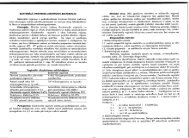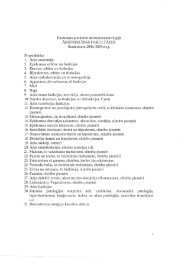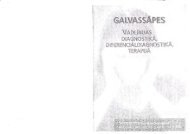PHYSICS
n - susliks.lv
n - susliks.lv
- No tags were found...
You also want an ePaper? Increase the reach of your titles
YUMPU automatically turns print PDFs into web optimized ePapers that Google loves.
light coming through the opening behaves as a single point<br />
source, so that the light emerges in all directions, instead of just<br />
passing straight through the slit.<br />
Consider light waves coming from various portions of the slit.<br />
The character of the diffraction pattern depends on the phase<br />
difference between the waves (fig. 21.12).<br />
The conditions for minima are:<br />
asinn = ms, where m = 1, 2, 3, ... (21.9)<br />
The conditions for maxima are:<br />
. (2m+I)A<br />
astns 8 = 2 ' where m = 1,2,3, '" (21.10)<br />
21.3.6. Measurement of Mean Erythrocyte Size<br />
Thomas Young, in 1813, was the first to apply the principle of<br />
diffraction to the measurement of spherical objects such as human<br />
erythrocytes. The princi ple of the erythrocytometer depends<br />
on the fact that the size of the diffraction spectrum varies with<br />
the size of the red cells and its distance from the light source. The<br />
device consists of two cylinders, one of which telescopes into the<br />
other. The outer cylinder can be moved up or down thus varying<br />
the distance between the top of the outer cylinder and the<br />
bottom of the inner cylinder. A metal disk is inserted across the<br />
bore of the inner cylinder. The disk has a small central aperture to<br />
emit a beam of light producing the diffraction spectrum. At the<br />
top of the outer cylinder is a slot for holding a slide containing a<br />
thin film of blood. The distance of the film from the light source<br />
is adjusted until the inner ring of the spectrum directly overlays<br />
the inner circle of the hole. The mean size of the erythrocytes is<br />
read directly in micrometers.<br />
21.3.7. Diffraction Grating<br />
A diffraction grating consists of a large number of equally<br />
spaced parallel slits (fig. 21.13). A grating can be made by engraving<br />
parallel lines on a glass plate using a precision machining<br />
technique. The number (N) of lines can be varied from 600 to<br />
ISO<br />
Fig. 21.13. Diffraction grating<br />
2800 l l ines/rnm. The slit spacing<br />
(d) equals to the inverse<br />
of this number, or:<br />
d = I/N (21.11)<br />
The equation for diffraction<br />
grating describes the condition<br />
for maxima in the interference<br />
pattern at the angle e :<br />
dsin8 = ms: (m = 0, 1, 2, 3, ... ) (21.12)<br />
The diffraction grating is used in physics to determine precisely<br />
the wavelength of a source of light.<br />
Example. Monochromatic light from a helium-neon laser (wavelength<br />
632.8 nm) is incident normally on a diffraction grating containing<br />
N = 6000 lines/em. Find the angle at which one would observe the firstorder<br />
maximum.<br />
Solution. A slit spacing d of the diffraction grating is equal to the<br />
inverse of the number N, or d = liN = 1/6000 m = 1.667.10- 6 m. For<br />
the first-order maximum (m = 1), we obtain from the equation for<br />
diffraction grating:<br />
dsinn = A<br />
sinO =A /d = 0.3797<br />
o = 22.31".<br />
21.3.8. X-Ray Diffraction and Structure of DNA<br />
The amount of information that can be derived from the examination<br />
of any material depends ultimately on how fine a probe<br />
is used. For example, examination of biological tissue using an<br />
optical microscope is limited by the wavelength of visible light<br />
that is in the 500 nm region. The wavelength of X-rays, in contrast,<br />
is in the 0.1 nm region, so they provide an excellent probe.<br />
In the early 1950's, J.D. Watson and F.H.C. Crick utilized the<br />
X- ray diffraction techniques to deduce the double helical<br />
structure of deoxyribonucleic acid (DNA). They realized that the<br />
151






